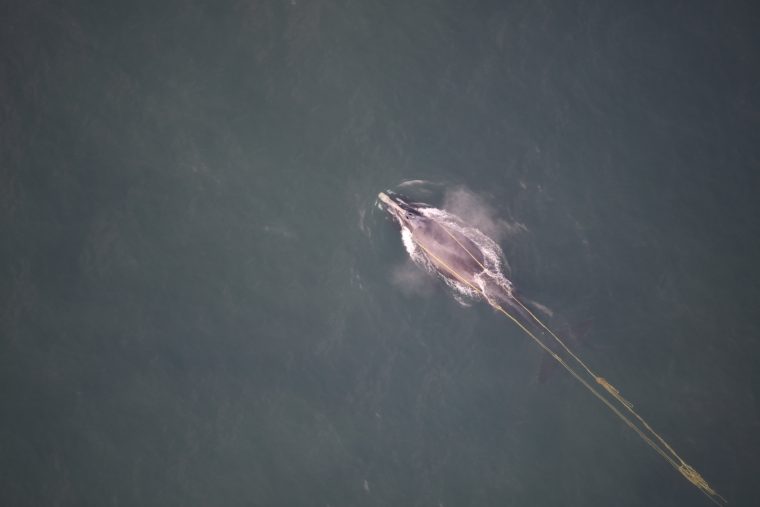Aquarium scientists strongly urge NOAA to consider more aggressive steps to save North Atlantic right whales from extinction

BOSTON, MASS. (March 1, 2021) – For more than 40 years, scientists at the New England Aquarium have been researching North Atlantic right whales with the goal of saving this iconic and critically endangered species that plays a vital role in marine ecosystems. In the past decade, we have seen an increase in serious injuries and deaths of right whales from fishing gear entanglements and vessel strikes. These injuries affect future reproduction and long-term survival for the approximately 350 whales remaining.
As leading experts in this area, we have strong reservations about the proposed federal rule from the National Oceanic and Atmospheric Association (NOAA) intended to limit the fishing gear entanglement risk for right whales by 60%. While the proposed rule to amend the Atlantic Large Whale Take Reduction Plan represents a start to implementing critically needed measures to save right whales, it does not go far enough. Immediate, bold federal action and a commitment to implementing ropeless fishing technology are needed to ensure this species will survive and rebound.
After careful consideration and analysis, Aquarium scientists submitted a comment (which can be read in full here) strongly urging NOAA to consider more aggressive steps to save these whales from extinction, including:
- Reducing the risk of entanglements in the U.S. lobster and crab fishery by at least 80%. Aquarium scientists say 60% is not sufficient to sustain the species and does not reflect the current, best available science. (This is outlined further in a separate comment the Aquarium submitted in response to NOAA’s “no jeopardy” finding in the draft Biological Opinion on 10 Fishery Management Plans. That comment can be read here.)
- Developing a process for implementing additional or extending existing closures quickly should the whales shift toward unprotected areas when changing migratory and feeding patterns.
- Advancing a strategy to phase in ropeless fishing gear that includes financial support and subsidies for the fishing industry. The Aquarium considers ropeless fishing gear as the key to a future in which fishing and North Atlantic right whales can coexist and supports NOAA’s proposal to allow this gear in newly proposed closed areas.
- As an interim measure outside of closed areas, implementing manufactured 1700-pound breaking strength ropes or insertions every 40 feet throughout the endline—the line to which the surface buoy is attached—to reduce the risk of lethal entanglements.
- Addressing effort reduction as a tool to reduce risk in the final published rule. Our scientists cite the effectiveness of limiting the number of traps and licenses over time to control the number of vertical lines in the water, therefore decreasing the likelihood of a whale encountering fishing gear.
- Placing less of a priority on state-specific gear marking, which itself does not reduce the risk to right whales of entanglements in fishing gear, though it can provide valuable information for fishery managers.
We cannot emphasize enough that bold and quick action is required if we are to save North Atlantic right whales from extinction. If strengthened, this far-reaching federal rule has the potential to preserve the future of right whales. The science shows a clear path forward for preventing unnecessary entanglement-related deaths and serious injuries. This is a problem we can solve, and the Aquarium looks forward to working in collaboration with the fishing industry, conservationists, scientists, and government agencies to be a part of the solution.
